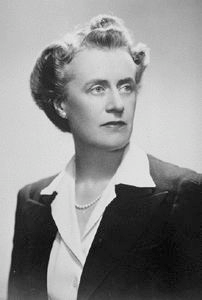Thérèse Casgrain
| The Hon. Thérèse Forget Casgrain | |
|---|---|
 Thérèse Forget Casgrain, c. 1942 | |
| Senator for Mille Isles, Quebec | |
|
In office October 7, 1970 – July 10, 1971 | |
| Appointed by | Pierre Trudeau |
| Preceded by | Gustave Monette |
| Succeeded by | Renaude Lapointe |
| Leader of the Parti social démocratique du Québec | |
|
In office 1951–1957 | |
| Preceded by | Romuald-Joseph Lamoureux |
| Succeeded by | Michel Chartrand |
| Personal details | |
| Born |
July 10, 1896 Montreal, Quebec |
| Died | November 3, 1981 (aged 85) |
| Political party |
Co-operative Commonwealth Federation (1945-1961) Parti social démocratique du Québec New Democratic Party (1961-1970) Independent |
| Spouse(s) | Pierre-François Casgrain |
| Relations | Rodolphe Forget, father |
Thérèse Casgrain, CC OBE LL.D. (10 July 1896 – 3 November 1981) was a Canadian feminist, reformer, politician and senator.[1]
Life and career



Born in Montreal, Quebec, she was raised in a wealthy family, the daughter of Blanche (MacDonald), Lady Forget, and Sir Rodolphe Forget. She married Pierre-François Casgrain, a wealthy Liberal politician with whom she raised four children.
Casgrain led the women's suffrage movement in Quebec prior to World War II. She founded the Provincial Franchise Committee in 1921 and campaigned for women's rights and for the right to vote in Quebec elections, a right that was not won until 1940. From 1928 to 1942, she was the leader of the League for Women's Rights. In the 1930s, she hosted a popular radio show Fémina.
In the 1942 federal by-election, she stood as an "Independent Liberal" candidate in the Charlevoix-Saguenay riding, the same seat formerly held both by her father and by her husband.
Following World War II, she left the Liberal Party and joined the social democratic Co-operative Commonwealth Federation (CCF). In 1948, she became one of the federal vice presidents of the CCF. She led the Quebec wing of the party, the Parti social démocratique du Québec, from 1951 to 1957. She was therefore the first female leader of a political party in Canada. She was a CCF candidate in a 1952 federal by-election and in the 1953, 1957 and 1958 federal general elections and a New Democratic Party candidate in the 1962 and 1963 federal general elections. She also used her position as a platform to campaign against the government of Maurice Duplessis.
In the 1960s, she became a campaigner against nuclear weapons, founding the Quebec wing of Voice of Women. She also was a founder of the League for Human Rights and the Fédération des femmes du Québec. In the 1960s, she was president of the Quebec wing of the New Democratic Party, the CCF's successor.
Prime Minister Pierre Trudeau appointed Casgrain to the Canadian Senate in 1970, where she sat as an independent for nine months before reaching the mandatory retirement age of 75.
She died in 1981. Thérèse Casgrain's body is interred in the Cimetière Notre-Dame-des-Neiges in Montreal.
Recognition
In recognition of her achievements, in 1967, she was made an Officer of the Order of Canada, and in 1974, she was promoted to Companion.
In 1979, she was named one of the first winners of the Governor General's Award in Commemoration of the Persons Case.[2]
In 1980 she received an honorary doctorate from Concordia University.[3]
In 1982, the Thérèse Casgrain Volunteer Award was created in 1982 by the Liberal government of Pierre Trudeau. It was discontinued in 1990 under the Conservative ministry of Brian Mulroney, but was begun anew in 2001 under the Liberal ministry of Jean Chrétien. In 2010, during the Conservative ministry of Stephen Harper, the award was eliminated and then repackaged as the "Prime Minister's Volunteer Award".[4] In 2016 under the Liberal government of Justin Trudeau the award was once again renamed as the Thérèse Casgrain Lifetime Volunteer Achievement Award.[5]
In 1985, Canada Post honoured Thérèse Casgrain with a postage stamp.[6] She also was commemorated in 2004 on the reverse of the $50 banknote of the Canadian Journey Series along with The Famous Five.[7] This commemoration was discontinued in 2012 with the introduction of a new design on the reverse of the fifty-dollar bill.[4]
In 2012, the Hon. Pauline Marois, first female premier of Quebec, unveiled a statue of Casgrain, Idola Saint-Jean and Marie-Claire Kirkland. The statue by Jules Lasalle was to celebrate the 50th anniversary of Kirkland being made the first Canadian female minister.[8]
References
- ↑ KALBFLEISCH, JOHN (4 September 2012). "Quebec, 1944: Finally, women are allowed to vote". The Gazette. Archived from the original on 4 September 2012.
- ↑ "Governor General's Awards in Commemoration of the Persons Case: 1979 Recipients". Status of Women Canada. Archived from the original on June 13, 2008. Retrieved 11 Feb 2016.
- ↑ "Honorary Degree Citation - Thérèse Casgrain* | Concordia University Archives". archives.concordia.ca. Retrieved 2016-04-11.
- 1 2 Beeby, Dean (27 July 2014), "Thérèse Casgrain removed from public history", Surrey Leader (Canadian Press), retrieved 27 July 2014
- ↑ http://news.gc.ca/web/article-en.do?nid=1049699&tp=1&_ga=1.28128700.1854602087.1454689894
- ↑ Postage Stamp
- ↑ The Art and Design of Canadian Bank Notes (PDF). Bank of Canada. 6 December 2006. ISBN 0660632462.
- ↑ Monument to women in politics, Radio Canada, in French, retrieved 28 December 2014
External links
- Office of the Governor General of Canada. Order of Canada citation. Queen's Printer for Canada. Retrieved 26 May 2010
- Thérèse Casgrain – Parliament of Canada biography
- Library and Archives Canada Biography